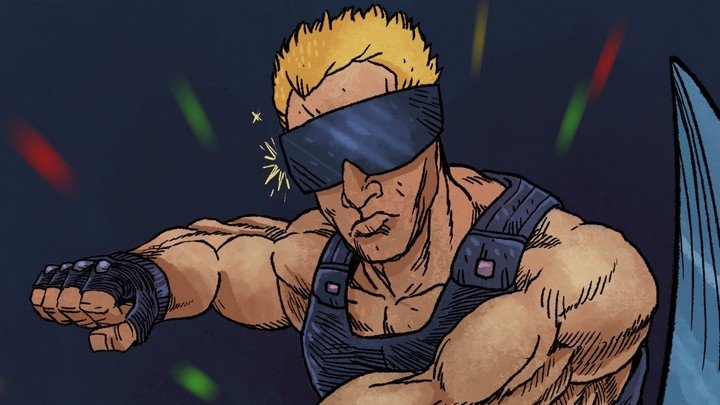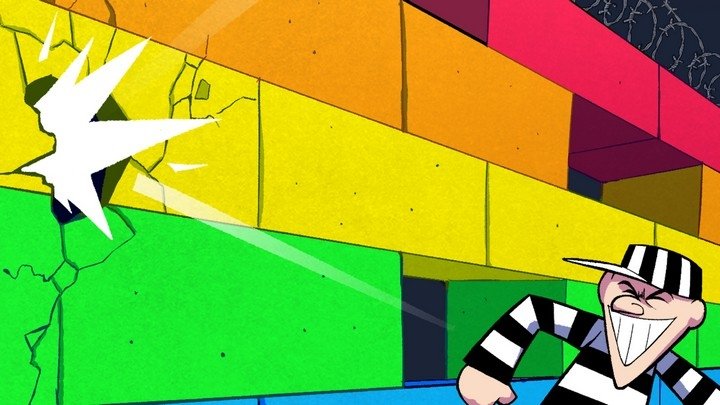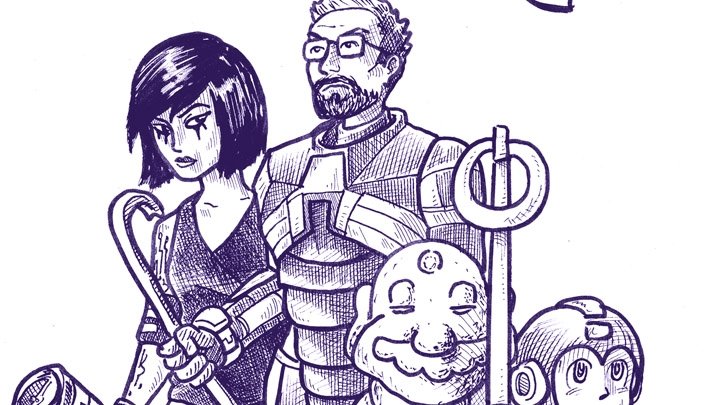Arkanoid vs Space Invaders is the block-breaking puzzle shoot-'em-up you never knew you wanted
A mash-up smash.
 Atari created Breakout in 1976 as a single-player counterpart to Pong, giving one player a formation of blocks to destroy with their ball and paddle in lieu of a human opponent. Like many primitive game concepts—including Pong itself—it went on to be widely imitated, cloned, and ported to every platform under the sun, including a number of dedicated plug-and-play consoles in the late '70s. But the arcade scene eventually moved on to bigger thrills, and Breakout had the odd distinction of already being old hat by the golden age of the mid-'80s. So Taito had a flash of brilliance when they revisited it ten years later with 1986's Arkanoid, updating the game in the visual language of vertical shoot-'em-ups, which was then the genre of the day. Each stage of Arkanoid presented a unique layout incorporating wrinkles such as indestructible gold blocks and enemies that would obstruct the ball's path, providing new challenges in addition to the simple trick of aiming the ball and not letting it fall. To help out with this, the player could augment the paddle—technically a conveniently paddle-shaped spaceship called the Vaus—with a variety of power-ups, including increasing the Vaus's length, adding lasers that let it shoot out blocks directly, and allowing it to "catch" the ball before firing it again from a desired position. Taito even included a perfunctory story and a final boss in the form of the malicious Moai head, Doh.
Atari created Breakout in 1976 as a single-player counterpart to Pong, giving one player a formation of blocks to destroy with their ball and paddle in lieu of a human opponent. Like many primitive game concepts—including Pong itself—it went on to be widely imitated, cloned, and ported to every platform under the sun, including a number of dedicated plug-and-play consoles in the late '70s. But the arcade scene eventually moved on to bigger thrills, and Breakout had the odd distinction of already being old hat by the golden age of the mid-'80s. So Taito had a flash of brilliance when they revisited it ten years later with 1986's Arkanoid, updating the game in the visual language of vertical shoot-'em-ups, which was then the genre of the day. Each stage of Arkanoid presented a unique layout incorporating wrinkles such as indestructible gold blocks and enemies that would obstruct the ball's path, providing new challenges in addition to the simple trick of aiming the ball and not letting it fall. To help out with this, the player could augment the paddle—technically a conveniently paddle-shaped spaceship called the Vaus—with a variety of power-ups, including increasing the Vaus's length, adding lasers that let it shoot out blocks directly, and allowing it to "catch" the ball before firing it again from a desired position. Taito even included a perfunctory story and a final boss in the form of the malicious Moai head, Doh.
 Arkanoid proved a great success in modernizing Breakout, garnering its own share of imitators and even a line of sequels. However, each new game ultimately amounted to an iteration on the same idea, offering only new stages and new power-ups in the best of cases. There's nothing wrong with more Arkanoid, of course, but it's amazing that it never saw any significant evolution...until now, that is. Arkanoid vs Space Invaders is Taito's first real attempt at branching out from the original game's framework and exploring the possibilities beyond it.
Arkanoid proved a great success in modernizing Breakout, garnering its own share of imitators and even a line of sequels. However, each new game ultimately amounted to an iteration on the same idea, offering only new stages and new power-ups in the best of cases. There's nothing wrong with more Arkanoid, of course, but it's amazing that it never saw any significant evolution...until now, that is. Arkanoid vs Space Invaders is Taito's first real attempt at branching out from the original game's framework and exploring the possibilities beyond it.
Put simply, Arkanoid vs Space Invaders goes back to the original idea of infusing Breakout with shoot-'em-up sensibilities and takes it several steps further with a little help from Space Invaders, Taito's 1978 classic that kicked off the genre in the first place. Rather than advance down the screen as in their own game, the Invaders hang out at a fixed altitude and rain all manner of projectiles on the Vaus. The Vaus, for once, is without a ball of its own, so it "attacks" by reflecting the Invaders' shots back up at them. Each stage is timed, and the only way to fail is to run out of time before eliminating all your targets: Letting enemy fire slip past the Vaus costs nothing but your combo and the  opportunity to turn it to your advantage. Reflecting fire also fills up a gauge on the sides of the screen; when full, you enter Attack Mode, where you can aim one shot anywhere you like. While reflected shots disappear when they hit an enemy, a block, or the top of the screen, the Attack Mode volley behaves much like the ball from Arkanoid, carrying on clear through Invaders and persisting after bouncing off blocks and the backboard, only disappearing when you drop it or the gauge runs out.
opportunity to turn it to your advantage. Reflecting fire also fills up a gauge on the sides of the screen; when full, you enter Attack Mode, where you can aim one shot anywhere you like. While reflected shots disappear when they hit an enemy, a block, or the top of the screen, the Attack Mode volley behaves much like the ball from Arkanoid, carrying on clear through Invaders and persisting after bouncing off blocks and the backboard, only disappearing when you drop it or the gauge runs out.
At first, your goal in any stage is to take out the Invaders, with blocks merely getting between you and them. As you progress, though, some stages make the blocks your objective, with infinitely respawning Invaders providing a reliable supply of ammo. Further in still are stages that task you with destroying specific targets called Cores. The layouts are more puzzle-like than ever before and sprinkle in new mechanics along the way, such as bombs that destroy everything on a line when struck, switches that render golden blocks and Invaders vulnerable, and conveyor belt fields that alter the trajectory of any shots that pass through them. The blocks themselves also become more rambunctious, wandering around the screen in confounding formations that demand you carefully aim your shots. To this end, the Vaus is no longer limited to horizontal movement; you can position it anywhere within the bottom quarter of the screen, allowing for an unprecedented degree of variation on where you can send each shot. The touch controls work brilliantly here, with a nuanced analog feel hearkening to Arkanoid's dial control in the arcade.
 As with any good puzzle game, all the above-mentioned factors gradually begin to intersect and overlap in increasingly complicated configurations. Fortunately, advancing through the game also unlocks a cavalcade of Taito characters whom you can call to the Vaus's aid, from all-stars like Lufia and Bubble Bobble's dragons to more obscure faces like Zac from PuLiRuLa and Nico from Spica Adventure. (Someone on the game's staff evidently has a thing for Psychic Force, as no fewer than four representatives from Taito's fighting game series made the cut.) Replacing traditional power-ups, each character has a special skill that can be activated for a limited time after collecting an icon from a downed block or Invader. These include speeding up your shots, filling the Attack Mode gauge more quickly, refilling the timer when you reflect fire (a skill appropriately held by Reika from Time Gal), preventing the Attack Mode gauge from depleting, and the disorienting but potentially game-breaking ability to steer your shots manually. A skill that adds a homing feature to your shots can be indispensable in stages where Invaders are your target, whereas stages with blocks that need breaking may benefit from a skill that lets your Attack Mode shot punch through multiple blocks without bouncing off. Meanwhile, skills that focus on increasing your firepower tend to come in handy during boss fights. Over the course of the game, identifying the right skill for any given job becomes just as critical to success as aiming and deflecting. Then again, calling down Great Thing from Darius (a huge battleship shaped like a sperm whale, if you don't know) to annihilate your foes is a pleasure unto itself.
As with any good puzzle game, all the above-mentioned factors gradually begin to intersect and overlap in increasingly complicated configurations. Fortunately, advancing through the game also unlocks a cavalcade of Taito characters whom you can call to the Vaus's aid, from all-stars like Lufia and Bubble Bobble's dragons to more obscure faces like Zac from PuLiRuLa and Nico from Spica Adventure. (Someone on the game's staff evidently has a thing for Psychic Force, as no fewer than four representatives from Taito's fighting game series made the cut.) Replacing traditional power-ups, each character has a special skill that can be activated for a limited time after collecting an icon from a downed block or Invader. These include speeding up your shots, filling the Attack Mode gauge more quickly, refilling the timer when you reflect fire (a skill appropriately held by Reika from Time Gal), preventing the Attack Mode gauge from depleting, and the disorienting but potentially game-breaking ability to steer your shots manually. A skill that adds a homing feature to your shots can be indispensable in stages where Invaders are your target, whereas stages with blocks that need breaking may benefit from a skill that lets your Attack Mode shot punch through multiple blocks without bouncing off. Meanwhile, skills that focus on increasing your firepower tend to come in handy during boss fights. Over the course of the game, identifying the right skill for any given job becomes just as critical to success as aiming and deflecting. Then again, calling down Great Thing from Darius (a huge battleship shaped like a sperm whale, if you don't know) to annihilate your foes is a pleasure unto itself.
 Arkanoid vs Space Invaders was originally released in September 2015 as a Japan-exclusive free-to-play game for Naver Corporation's Line app, where it was discontinued after a year before being relaunched worldwide as a standalone app last month. While it looks and plays the same now as it did then, its structure has been thoroughly redesigned, jettisoning the gacha pulls, arduous grinding, and gross incentivization of microtransactions that typify mobile games at their absolute worst. The game now offers a wealth of content, including 150 stages, two difficulty modes, and an endless score attack mode, all for a flat four dollars. While many of the nickel-and-dime perks from the F2P version remain in the game, they're now either unlocked naturally or can be bought with an in-game currency accrued simply by playing well.
Arkanoid vs Space Invaders was originally released in September 2015 as a Japan-exclusive free-to-play game for Naver Corporation's Line app, where it was discontinued after a year before being relaunched worldwide as a standalone app last month. While it looks and plays the same now as it did then, its structure has been thoroughly redesigned, jettisoning the gacha pulls, arduous grinding, and gross incentivization of microtransactions that typify mobile games at their absolute worst. The game now offers a wealth of content, including 150 stages, two difficulty modes, and an endless score attack mode, all for a flat four dollars. While many of the nickel-and-dime perks from the F2P version remain in the game, they're now either unlocked naturally or can be bought with an in-game currency accrued simply by playing well.
In its original incarnation, this game might have been mourned as a missed opportunity, so it's a great thing indeed that Taito acknowledged its potential and made the effort to rethink its execution. As 2008's Space Invaders Extreme was to Space Invaders, Arkanoid vs Space Invaders represents a truly transformative reinvention of a concept with timeless appeal. At long last, Arkanoid has received the worthy successor it always deserved—and also like Space Invaders Extreme, it only took thirty years.




